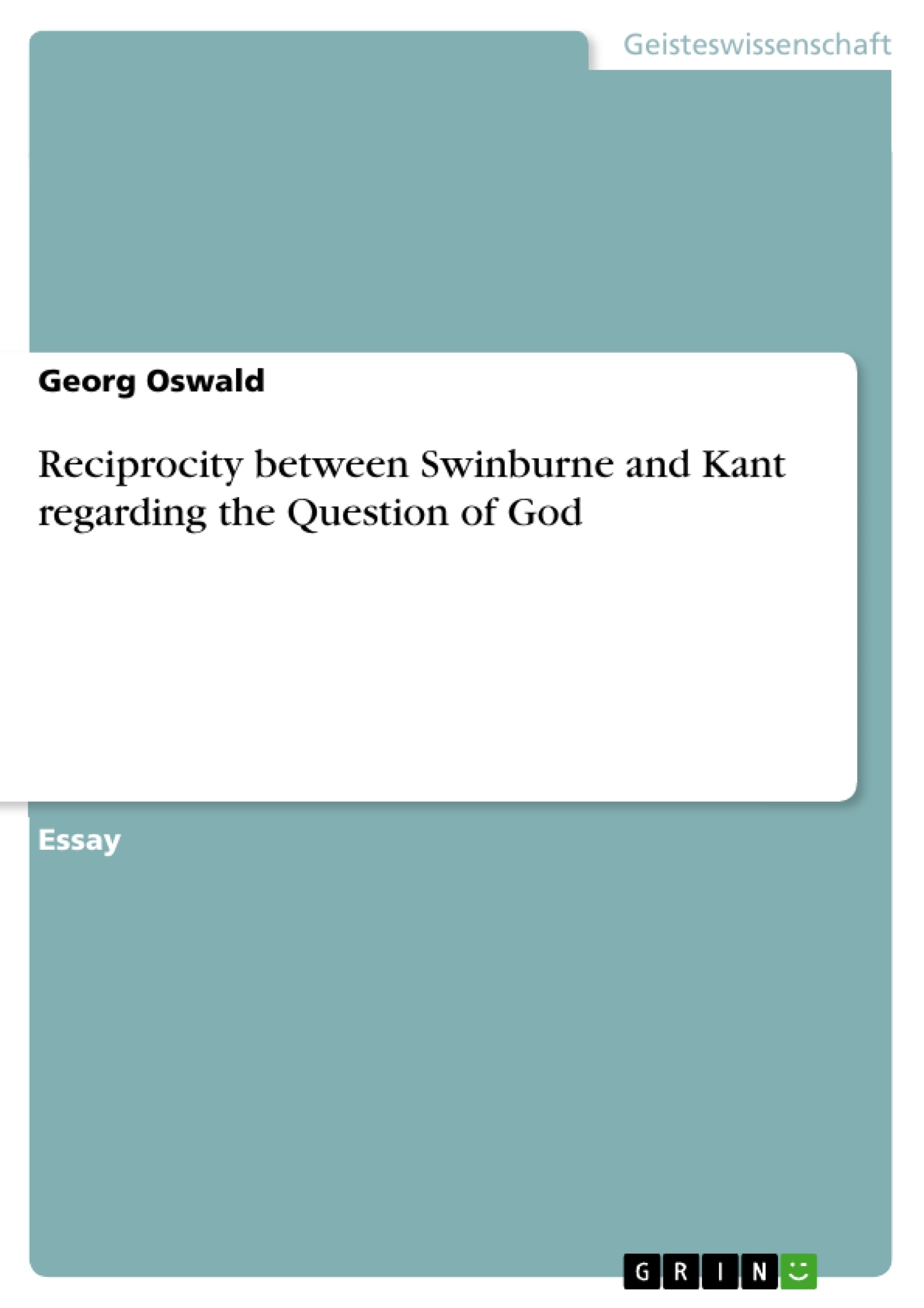The theme of this essay revolves around the post-Kantian debate on different attempts to unearth new arguments for the existence of God. One of the first analytic philosophers in the tradition of the philosophy of religion, RICHARD SWINBURNE (born 26 Dec 1934), caused a furor with the publication of his trilogy – The Coherence of Theism, The Existence of God and Faith and Reason. While his first book – The Coherence of Theism (1977) – addresses the question as to whether God can be conceived as internally coherent, his second book – The Existence of God (1st Edition 1979, 2nd Edition 2004) – explicates a detailed analysis of whether God’s existence is true or false.1 Assuming that God’s existence is not “demonstrably incoherent (i.e. logically impossible)”2, which he concludes from his first book, Swinburne’s main task is to analyze whether religious experience can provide specific information on God’s existence. With this in mind, Swinburne directs his arguments against Kant whom he mentions explicitly more than 35 times in his book.3 Kant, who with his critique of pure reason, casts the question of God’s existence out beyond the range of immediate experience, builds the fundament for Swinburne’s criticism and his aim to justify God’s existence through immediate experience. Kant emphasizes namely, that God is an idea conceived in the transcendental subject, but cannot be experienced or perceived directly.
Inhaltsverzeichnis
- Introduction
- §1 Swinburne's Principal Premise in his Introduction to Chapter 13
- §2 The Nature of Religious Experience
- §3 The Principle of Credulity
- §4 Kant's Postulate of Practical Reason
- §5 Kant and the Aesthetic Approach to Religious Experience
- Conclusion
Zielsetzung und Themenschwerpunkte
Dieser Essay befasst sich mit der post-kantischen Debatte über verschiedene Versuche, neue Argumente für die Existenz Gottes zu finden. Richard Swinburne, einer der ersten analytischen Philosophen in der Tradition der Religionsphilosophie, sorgte mit der Veröffentlichung seiner Trilogie - The Coherence of Theism, The Existence of God und Faith and Reason - für Aufsehen. Während sein erstes Buch - The Coherence of Theism (1977) - die Frage behandelt, ob Gott als intern kohärent gedacht werden kann, analysiert sein zweites Buch - The Existence of God (1. Auflage 1979, 2. Auflage 2004) - detailliert, ob Gottes Existenz wahr oder falsch ist.¹ Unter der Annahme, dass Gottes Existenz nicht „demonstrabel inkohärent (d. h. logisch unmöglich)“² ist, was er aus seinem ersten Buch folgert, ist Swinburnes Hauptaufgabe zu analysieren, ob religiöse Erfahrung spezifische Informationen über Gottes Existenz liefern kann. In diesem Sinne richtet Swinburne seine Argumente gegen Kant, den er in seinem Buch explizit mehr als 35 Mal erwähnt.³ Kant, der mit seiner Kritik der reinen Vernunft die Frage nach Gottes Existenz jenseits des Bereichs der unmittelbaren Erfahrung stellt, bildet das Fundament für Swinburnes Kritik und sein Ziel, Gottes Existenz durch unmittelbare Erfahrung zu rechtfertigen. Kant betont nämlich, dass Gott eine Idee ist, die im transzendentalen Subjekt gedacht wird, aber nicht direkt erfahren oder wahrgenommen werden kann.
- Analyse der Parallelen und Unterschiede in den Argumentationsstrukturen von Swinburne und Kant
- Untersuchung von Swinburnes Prinzip der Glaubwürdigkeit (PC) und seiner Beziehung zur kausalen Theorie der Wahrnehmung (CTP)
- Beurteilung von Kants Postulat der praktischen Vernunft und seiner Beziehung zur empirischen Welt
- Exploration des Kantianischen Ansatzes zur religiösen Erfahrung durch die Analyse von Kants dritter Kritik
- Bewertung der Möglichkeiten, die Existenz Gottes durch die Erfahrung zu begründen
Zusammenfassung der Kapitel
In Kapitel 13 - Arguments from Religious Experience - stellt Swinburne seine Argumente vor, die darauf abzielen, den rationalen Status religiöser Erfahrungen zu belegen. Um seine empirischen Argumente zu untermauern, definiert Swinburne Erfahrung als intentional, wobei das Objekt der Erfahrung unabhängig vom Subjekt existieren kann oder nicht. Der Essay analysiert die Beziehung zwischen Swinburnes Prinzip der Glaubwürdigkeit und Kants Postulat der praktischen Vernunft, um die formalen Parallelen zwischen ihren Argumentationsstrukturen aufzuzeigen.
Schlüsselwörter
Die zentralen Themen dieses Essays sind die Existenz Gottes, religiöse Erfahrung, Kants Kritik der reinen Vernunft, Swinburnes Prinzip der Glaubwürdigkeit, die kausale Theorie der Wahrnehmung und die Beziehung zwischen Subjekt und Objekt in der Erfahrung.
- Quote paper
- Master of Philosophy Georg Oswald (Author), 2006, Reciprocity between Swinburne and Kant regarding the Question of God, Munich, GRIN Verlag, https://www.grin.com/document/147580



